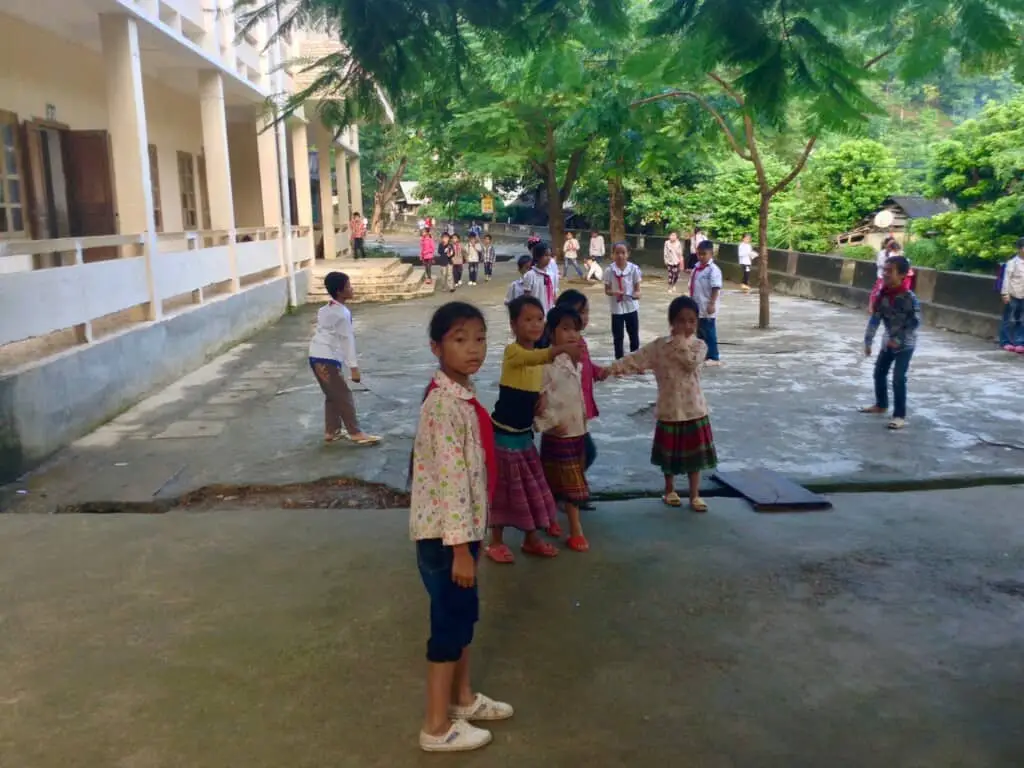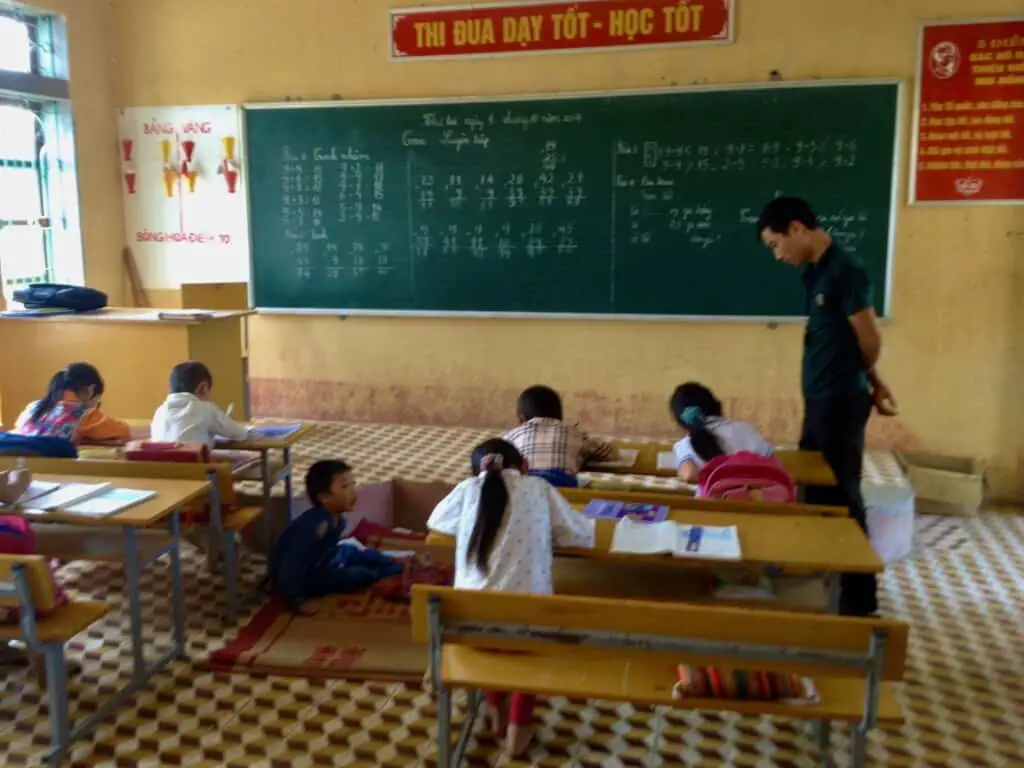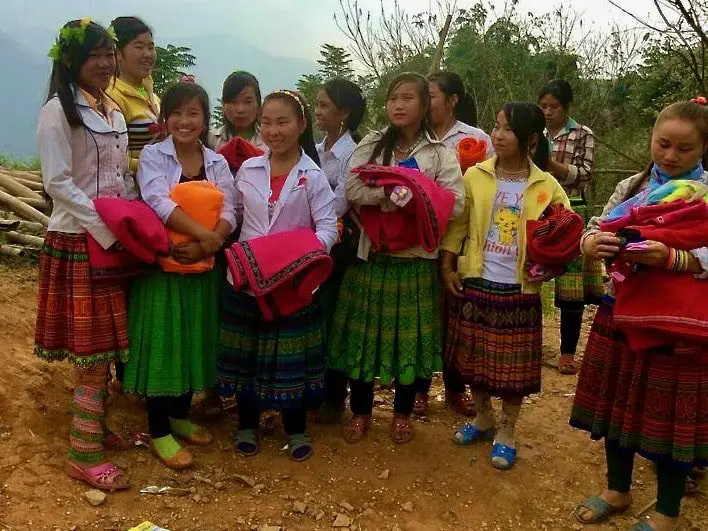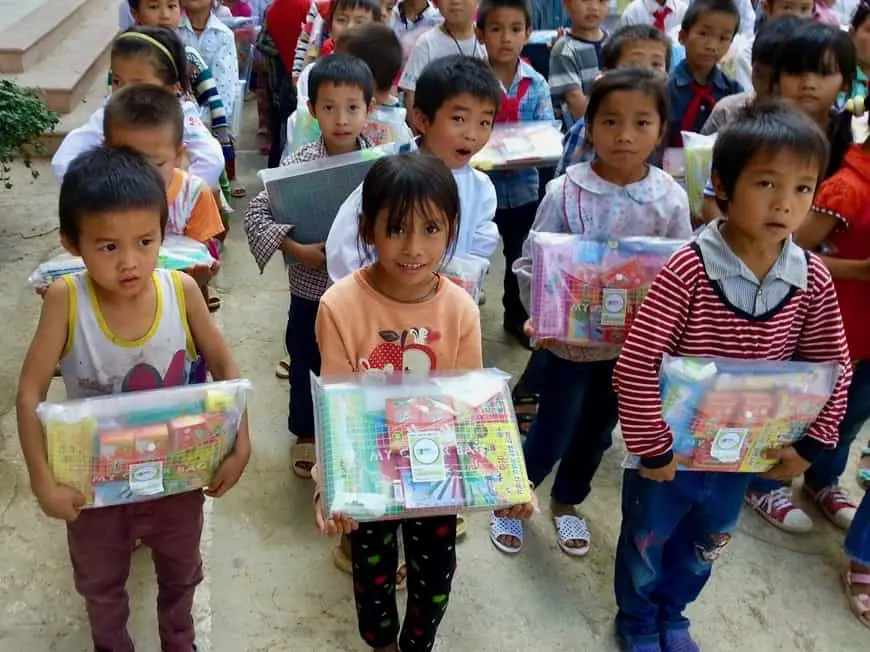I work with a charity called Project Sprouts that helps out the villages and impoverished schools in North Vietnam. Through our work in these schools, we have discovered a lot about the Vietnamese school system and its amazing principals and teachers who care about their students.
Vietnam has five different levels of education preschool, primary school, middle school, high school, and higher education. In North Vietnam, many of these schools are out in the countryside and due to the location and the area’s economies, it can be difficult for the children to get an education due to their life challenges. Project Sprouts is a Hanoi-based initiative that helps support education in these remote areas.
Table of Contents
- Vietnam’s Public School System Explained
- The Vietnamese Village Schools Explained
- Many Vietnamese Rural Schools Have Extremely Dedicated Principals and Teachers
- Some Rural Vietnamese Children Are Not Able To Attend School
- Project Sprouts Helps Needy Children in Vietnam’s Rural Schools
- Related Questions:

Vietnam’s Public School System Explained
Vietnam has a state-run public school system run by the Ministry of Education and Training (MOET). The Ministry of Education and Training oversees all education in Vietnam.
Education in Vietnam is divided into five levels: preschool, primary school, middle school, high school, and higher education. Formal education consists of twelve years of basic education.
Explanation of Different Classes For The Vietnam Public School System
The Vietnamese school system by each education level:
- Pre-school Children – Pre-school children are aged 18 months to 5 years old. This school is not compulsory, but many parents send their children to preschool starting at 18 months old. Parents must pay for this education, but those parents who are impoverished children are usually allowed to attend free or with some government subsidies. The preschool also acts as a kind of daycare for many parents where the mother and the father must work and have no other babysitter.
- Primary School Children – Children in Vietnam must attend primary school from six. The actual years of compulsory education are only five years of actual schooling. In Vietnam, at least 95% of all children are enrolled in at least some kind of primary school at some time. Primary school is not 100% free, as school fees must be paid, and students need uniforms and even special shoes. For parents who cannot afford the fees, the government or school will usually help with subsidies in some way.
- Secondary Schools – Middle and High School – The secondary school is split into two programs: middle or lower secondary school and High school, which is higher secondary. The lower secondary school is from ages 11 to 15 years old. The higher secondary school is until the age of 18 years old. Secondary school is not compulsory in Vietnam, and students must take an exam to see what school they can attend. Of course, for better schools, the competition can be extremely fierce. This is why many parents may insist that their children take extra classes to ensure they get into an excellent secondary school system.
- Higher Education – Vietnam has many universities, especially in major cities such as Hanoi and Ho Chi Minh. More and more Universities are being built, especially western-based or western-named universities. It is usually essential for parents who have money that their children go to University, and many of these parents will tell their children what they must study.
Most Vietnamese students study very hard. Their curriculum is considered to be rigorous in many of the schools. Vietnamese families with money will usually always have their children take extra evening and weekend classes to supplement their education.

The Vietnamese Village Schools Explained
Vietnam has many villages out in the countryside. Some of these villages can be quite far away from any other city, so they can be in a very remote area. Many of Vietnam’s minorities live in these remote mountain villages, so their children attend these village schools.
Many Vietnamese Schools Are Remote and Have Many Ethnic Minorities
Vietnam has over 53 ethnic minority groups, totaling about 8 million people. Many of these minority groups live in the north of Vietnam on the borders between Vietnam and China and Vietnam and Laos.
With our work with Project Sprouts, we have been up to many of the smaller village schools on the border of Vietnam. Normally an area will have one larger school that is down in the main town area, and then there can be a host of smaller village schools that are all attached under the care of the main school, but these smaller schools are up in the villages.
Some villages can be 10 or 15 kilometers straight up a dirt mountain road. This is because the people are farming on the mountainsides. Many of these farmers are Hmong. You can read about the Hmong by reading the blog Hmong History, People and Culture. by clicking here.
These village school schools usually have a preschool and then a primary school that has classes for grades one to three for the children in the village to attend. Once a child in the village is ready for the fourth grade, they must go to the main school in another town.
This may sound very easy, but the truth is for most of these families or students, this can be extremely difficult. These students will usually need to stay in a dorm at the school during the week and then go home only on the weekends.
Some Vietnamese Children Walk Long Distances To Attend School
Many of these young children will walk 25 kilometers down a mountain to school early Monday morning with their books on their backs and all their food for the week. The school does not provide food for them, so they need to bring food.
These students will stay at the school from Monday to Thursday night in a basic dorm room. These dorm rooms are usually overcrowded and extremely basic, with many other children in the same situation. On Friday afternoon, the children make the walk back home again.
You may ask why they don’t their parents drive them to school. Their parents would not own a car and some may only have one motorbike, I am sure some parents do drive their children to school, but many do not have the means or the time to help their children get to school.

Many Vietnamese Rural Schools Have Extremely Dedicated Principals and Teachers
As we have traveled out to many of these small village schools, the one thing we have been impressed with is that the principals and teachers are extremely dedicated. For many of them teaching at these schools is at a great personal sacrifice.
We have been with the principals of these country schools, and they could tell us about every student in their school and why the student is and is not in school. These principals know each of these families individually and all their stories and circumstances.
Teaching in Vietnam’s Rural Schools Can Be Very Challenging.
Teaching in these village schools is extremely challenging. Many of these schools may have a building, but the windows may be broken, and the roof leaks. Many schools do not even have a toilet or sanitation facilities. The students and the teachers must go out to the fields to relieve themselves.
Many of these teachers and principals may live so far away that during the week, they must stay at the school, usually sleeping on a cot in their office. I have met teachers in some of the village schools that travel over 25 kilometers each way to teach each day in a mountain school.
For 10 kilometers, they needed to travel straight-up mountain roads that were so difficult to travel that they had to put chains on their motorbikes to even get up the roads during the rainy season.

Some Rural Vietnamese Children Are Not Able To Attend School
Many children out in the mountain and remote areas are not in school or can only attend primary school and not Secondary or get a Higher Education. I have found that almost all these children who are not in school, really want to be able to still attend school. Due to their circumstances, attending school is not an option.
Reasons Why Some Rural Vietnamese Children Are Not Able To Attend School
Here are some of the reasons why some of these children are not able to attend school:
- Economic necessity – For some of the families, they cannot afford for their children to attend school. Even if the school is free, once the children hit the 4th grade and need to go to the main school and stay in the dorm, they need to provide food and living for that child separated from their family. This can cause economic hardship for families. This can also affect many of these impoverished children for their secondary and higher education prospects, as their families do not have the means to help them with their continuing education.
- Need to babysit younger siblings – Like the economic necessity, some of these families, need to have the older children help tend to some of the younger children. Many times this can affect the daughters more than the sons. Children as young as 8 or 9 can be full-time caregivers to a younger sibling.
- Distance is too far to attend school – The distance may be too far for some children to attend school. It may be that they are not able to even walk the distance to school and they have no means of transportation to the school.
- Special Needs and there are no programs – Some of the students may be ill or have other special needs, and there are no programs for them. We once met a boy named Loi in one of these village schools, and his father carried him to the village school each day to sit on a mat and go to class as he could not sit in a chair and could not walk. Once Loi got into the 4th grade, he could no longer attend school as there were no special programs for him, and his family had no means to send him to the school in the next town.

Project Sprouts Helps Needy Children in Vietnam’s
Rural Schools
Project Sprouts is a Hanoi-based initiative whose main focus is to help impoverished schools in North Vietnam. They realize that we cannot solve all the problems for the village schools but feel we can try to somehow make a difference in the lives of these children and these teachers and the people in the villages.
How Project Sprouts Helps Needy Rural Students
Here is how Project Sprouts helps these village schools and communities in Vietnam:
- Student school supplies – At the beginning of each school year, we give out school supply kits to the students. Many of these students live far away from schools and in villages where it is tough to purchase any school supplies.
- Teacher supplies – Just like the students need school supplies, the teachers can also use some. So we give the teachers some school supplies to help supplement their teaching.
- Winter coats and boots – Many of these children live up in the mountains, so they may walk for miles in plastic flip-flops, even in the freezing winter weather. We help these children by helping to provide them with winter coats and plastic boots to keep them warm.
- Re-distribute clothing and other slightly used items – We collect some slightly used clothing, toys, books, and other items from the Hanoi community and other places to re-distribute them into these mountain areas. We will give this clothing to the community.
You can learn more about Project Sprouts and their work in these villages and village schools in Vietnam by clicking here.

Despite many of these educational challenges in the villages, Vietnam’s education and literacy rates are quite high. This is undoubtedly due to the dedication of many teachers and school principals who know their students and try to do all they can to help them achieve their educational goals.
At A Bus On A Dusty Road, we talk about travel, life, sailing, and ex-pat living. We are all about “Living Life As A Global Citizen.” We explore social, cultural, and economic issues and travel.
We would love to have you be part of our community. Sign up for our newsletter to keep up-to-date by clicking here. If you have any questions, you can contact me, Anita, by clicking here.
Listen to our Podcast called Dusty Roads. You can find it on all major podcast platforms. Try out listening to one of our podcasts by clicking here.
Subscribe to our A Bus On A Dusty Road YouTube Channel with great videos and information by clicking here
Related Questions:
Do I need to speak Vietnamese in Vietnam?
Learning to speak a few words in Vietnamese will help you have a better trip to Vietnam. As with any place you travel, if you can pick up a few local words, it usually shows the local people that you want to try to get to know a bit more about their country and culture.
In Hanoi, Danang or Ho Chi Minh, or the major tourist areas, many people will speak English. As you get out more in the countryside, finding people who can speak English is usually harder. If you plan to travel out into the countryside, you may need a translator.
Do I need a Visa to travel to Vietnam?
Most countries will need to have a visa to travel to Vietnam. Visitors coming to Vietnam must organize and look at a Vietnam travel visa before entering Vietnam. There are several ways to obtain a Vietnamese visa at the Vietnamese Embassy, online through an agent or visa at the border. In some circumstances and for some nationalities, Vietnam also offers visa-free exemptions.
You can find out more about getting a Vietnamese Visa by reading our blog Vietnam Travel Visa, What You Need to Know Before You Go.by clicking here.



One response to “Helping Students Learn & Grow – Vietnamese Schools”
Your article helped me a lot, is there any more related content? Thanks! https://accounts.binance.com/en/register?ref=W0BCQMF1